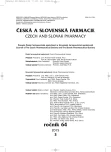Pharmaceutical history of capuchin monastery in Prague-Hradčan
Part II. Capuchin balsam (Balsamum capucinorum)
Authors:
Karel Nesměrák; Jana Kunešová
Authors‘ workplace:
Oddělení starších českých dějin
; Katedra analytické chemie
; Národní muzeum, Historické muzeum
; Univerzita Karlova v Praze, Přírodovědecká fakulta
Published in:
Čes. slov. Farm., 2015; 64, 95-99
Category:
History of Pharmacy
Overview
The history of traditional capuchin balsam is the focal point of the second part of the article on the unknown history of pharmacy at the capuchin monastery in Prague-Hradčany. Capuchin balsam, a medicinal speciality, was being manufactured in the monastery from the end of the 18th century till the year 1950. It is a spirit tincture, its prescription originating from the formulation by Oswald Croll. Balsamum Peruvianum, Gummiresina myrrha, Gummiresina olibanum, and Styrax are the main ingredients, besides assorted plants. The balsam was taken as an antiseptic, antiphlogistic, and analgesic. The balsam was a favoured rustic medicine, and it was sold also abroad (Germany, Poland, USA, Ireland, Belgium). The profit made from the sale of the balsam supported the reconstruction and the maintenance of the monastery and the local theological studies. Other medical formulations connected with the name of the capuchin order are also mentioned.
Key words:
pharmaceutical history • capuchins • capuchin balsam • monastics pharmacies
Sources
1. Schaller J. Beschreibung der königliche Haupt- und Residenzstadt Prag. Zweiter Band. Prag: F. Jeřábek 1795; 72–73.
2. NA ŘK, karton 378–380.
3. Drábek P. Naše léčivé přípravky na konci 18. století. I. část – úvod a tekuté lékové formy. Čes. slov. Farm. 2011; 60, 247–254.
4. Drábek P. Farmacie v rudolfínské době. In: Purš I., Karpenko V. (eds.) Alchymie a Rudolf II. Praha: Artefactum 2011; 687–704. Hausenblasová J. Mezi lékařstvím a politikou. Působení Oswalda Crolla v českých zemích v době vlády Rudolfa II. In: Purš I., Karpenko V. (eds.) Alchymie a Rudolf II. Praha: Artefactum 2011; 367–380.
5. Croll O. Basilica chymica, continens philosophicam propria laborum experientia confirmatam descriptionem et usum remediorum chymicorum selectissimorum e lumine gratiae et naturae desumptorum. Francofurti: Claudius Marinus 1609; 264–266.
6. Zedler J. H. Grosses vollständiges Universal-Lexicon aller Wissenschaften und Künste. Band IV. Halle und Leipzig 1733; col. 1733.
7. Schittny H. R. Über den Ursprung des Jerusalemer Balsams. Pharmazeutische Zeitung 1991; 136, 2210–2214.
8. Moussaieff A., Fride E., Amar Z., Lev E., Steinberg D., Gallily R., Mechoulama R. The Jerusalem Balsam: From the Franciscan Monastery in the old city of Jerusalem to Martindale 33. J. Ethnopharmacol. 2005; 101, 16–26.
9. Hager H. Handbuch der Pharmaceutischen Praxis. Erster Band. Berlin: Springer 1886; 557.
10. Kramers, J. G. H. Medicina castrensis chirurgica. Pars secunda. Nürnberg: Conrad Monath 1745; 66.
11. http://www.balsamkapucynski.pl/, 20. 3. 2015.
12. NA ŘK, karton 371.
13. NA ŘK, karton 373.
14. Preininger V. Sbírka zákonů a nařízení o zdravotnictví, se zvláštním zřetelem ku zemím koruny české. Praha: Bursík a Kohout 1900; 240–241.
15. NA ŘK, rukopis 91 Balsam-Betriebs-Auslagen und Einnahmen 1855–1865, rukopis 93 Balsam 1869–1883, karton 379.
16. NA ŘK, rukopis 92 Journal über Hofmannischer- und Melissentropfen-Betrieb.
17. Pancíř J. Vznik a právní poměr klášterních lékáren. Lék. listy 1923; 16: 273–274 a 279.
18. Šiška J. (red.) Administrační zpráva hlavního města Prahy za rok 1911. Praha: Důchody obce hlavního města Prahy 1919; 372.
19. Slovo „anglický“ bylo do názvu balzámu vsunuto z reklamních důvodů, neboť v druhé polovině 19. století byl dalším oblíbeným arkánem Englischer Wunderbalsam, což byla opět jedna odvozenina Crollovy receptury.
20. Anonym. Národní listy 1897; 31: 151, 3.
21. Pharmacopoea Wirtenbergica. Stutgardiae: Johann Christophorus Erhard 1750; 85.
22. Hager H. Handbuch der Pharmaceutischen Praxis. 1.–3. Band. Berlin: Springer 1886. Novák E., Nowak G., Roch F. Synonyma apothecariorum. Uibersichtliche Zusammenstellung der wissenschaftlichen und volksthümlichen Benennungen der pharmaceutischen Artikel in lateinischer, deutscher und böhmischer Sprache. Prag: Franz Roch 1890.
23. Hell G. Pharmaceutisch-technisches Manuale. I. Pharmaceutischer Theil. Troppau: Buchholz & Diebel 1886; 211.
24. Geissler E., Moeller J. (ed.) Real-Encyclopädie der gesammten Pharmacie. Band 1–11. Wien und Leipzig: Urban und Schwarzenberg 1886–1891.
Labels
Pharmacy Clinical pharmacologyArticle was published in
Czech and Slovak Pharmacy

2015 Issue 3
Most read in this issue
- Enhancing of drug bioavailability using liquisolid system formulation
- The quality of life of patients suffering from the osteoporosis
-
Effectiveness of phytotherapy in supportive treatment of type 2 diabetes mellitus
II. Fenugreek (Trigonella foenum-graecum) -
Pharmaceutical history of capuchin monastery in Prague-Hradčan
Part II. Capuchin balsam (Balsamum capucinorum)
